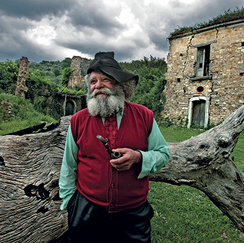Top 3 Ghost Towns You Must See In Campania Region (Italy)
Over time natural calamities (earthquakes, landslides) destroyed many villages in Campania region (Southern Italy) and for this reason they were abandoned. Even though the villages were later rebuilt few kilometers away from their original location, many of the destroyed villages are still in the same state of when were abandoned.
The following are the top 3 fascinating and misterious ghost villages that we recommend our guests to absolutely visit!
1. ROMAGNANO AL MONTE (The village of "speaking houses")

This ancient village is located at about 650 meters above sea level on the top of an impervious rocky spur that descends steeply to the underlying Platano river which forms the border between Campania and Basilicata region.
Romagnano al Monte was destroyed during the earthquake of 1980 and became a tourist attraction in the early 2000s.

Unique features of this village are the many steps scattered throughout the town which served to connect the various areas. The steps were also used as benches for those who wanted to rest and as entrance of the houses.
Narrow streets and abandoned houses give the feeling of a crumbling medieval town, despite electricity cables and other remnants of modernity. Inside the houses are still present personal belongings and objects of daily life. Among the ruins is an elegant church, standing silent in the wake of hundreds of years of worship.
A legend tells that the people who visited the village after 1980 said they heard squeaks and sinister noises as if the houses had a voice: houses that speak, complain and torment themselves in memory of the earthquake that left them empty.
SEE VIDEO (from min 28:00): http://www.raiplay.it/social/video/2017/12/GHOST-TOWN-57af5948-3f56-403e-9f1d-c942838e4446.html
2. ROSCIGNO VECCHIA (The one-man town)

Roscigno Vecchia is an intriguing ghost town hidden in the Cilento National Park.
The town is built in a way that brings to mind a large amphitheatre: a square with the eighteenth-century church, a fountain with watering places and public washrooms in the center, the curtain of the houses with shops, stables, cellars, and the narrow inner streets, the chapels, the cemetery and mule tracks leading to the fields.

Roscigno is an out-and-out open-sky museum. Taking a walk through the village is like leaping in the past to discover the culture and the soul of seemingly lost rural community.
The village was abandoned by its own residents because they were threatened by the landslide in 1902, and then transferred in the new town, far upstream in a safer ground.
Today the village has only one inhabitant, Giuseppe Spagnolo. He is the last custodian of a place out of the time, and his eyes are the historical and visual memory of this nature and these marvelous and wild mountains. When some tourists come, the elderly resident takes the opportunity to act as "cicerone" (a person who conducts sightseers).
SEE VIDEO: https://vimeo.com/105184729
3. SAN SEVERINO DI CENTOLA (The medieval ghost town)

San Severino di Centola is a medieval ghost village nestled on the grey and pink rocks overhanging the valley of the Mingardo river which here digs a narrow gorge called Gola del Diavolo (Devil’s Throat).
The village was abandoned in the 70s due to landslides and rebuilt down in the valley closer to a railway.

In the Middle Age the village had a fundamental strategic significance, as its position allowed it to control the valley below. And it was indeed to control and defend the territory that a number of watch tower were built, as well as a powerful castle, of which some remains can still be seen today, along with the abandoned houses which give the place a magic atmosphere.
Nowadays San Severino di Centola is a preserved heritage because of the conservation status of its medieval structure.
















































































Comments